I don't buy my audio gear based on what graphs says, because graphs will only show what's present but not what's missing, that can only be found out by listening tests and usually there's missing a lot.
I don't buy my audio gear based on what graphs says, because graphs will only show what's present but not what's missing, that can only be found out by listening tests and usually there's missing a lot.
It's up to you how you decide what you buy. But that still does not explain why you don't show any test data for those who are interested in this kind of stuff. Don't you have access to test equipment anymore (as you had for v1.2)?
All measuring gear still here it's just that I want to hear feedback from builders first, later the graphs can be commented and discussed.
I don't buy my audio gear based on what graphs says, because graphs will only show what's present but not what's missing, that can only be found out by listening tests and usually there's missing a lot.
+ 1000
.... First you have to ask yourself why tube amps with disastrous plots sounds fantastic, not all of them of course.
+ 1000
I am wondering all the time !!! Why ???
IMHO it is because we still cannot measure the parameters that are important for the reception of sound by the ear/brain system.
We measure what we are able to, and try to relate that to how that influence the reception of sound.
Example:
We can measure harmonic distortion to very low values, but the ear / brain is pretty tolerable to that. Partly because this is part of what musical instruments produce and partly because sound traveling a distance in air will have more harmonic distortion. On the other hand, we discovered that the early digital sounds were horrible, and learned that there was a time domain distortion (jitter) that the ear/brain was not very tolerable to.
But trying to relate all the imperfections in sound reproduction into one plot or figure, that is naive.
We measure what we are able to, and try to relate that to how that influence the reception of sound.
Example:
We can measure harmonic distortion to very low values, but the ear / brain is pretty tolerable to that. Partly because this is part of what musical instruments produce and partly because sound traveling a distance in air will have more harmonic distortion. On the other hand, we discovered that the early digital sounds were horrible, and learned that there was a time domain distortion (jitter) that the ear/brain was not very tolerable to.
But trying to relate all the imperfections in sound reproduction into one plot or figure, that is naive.
Hi LC,
Is the mono chassis design you mentioned a while back still alive and on-going?
If yes, any schedule, picture to share and cost estimate for it?
Thanks,
Eric
Is the mono chassis design you mentioned a while back still alive and on-going?
If yes, any schedule, picture to share and cost estimate for it?
Thanks,
Eric
First you have to ask yourself why tube amps with disastrous plots sounds fantastic, not all of them of course.
Some of them... I am asking myself - do any of them really sound fantastic? Or is it just a myth and some habit to specific distortion... I have heard disastrously sounding tube amps and have seen a group of people who were really enjoying this disaster. But yet I have to see a tube amp with disastrous plots that have some good sound. Subjective impressions distributed over the web also proven to mean pretty much nothing. If you make & sell the product - it is even less so as you have a bias.
So, the process stays the same - give me satisfactory specs (set of measurements) and then I decide if it is a good candidate to consider for my purpose. Not the other way around. If there is nothing to suggest it fits - no need to worry. The v1.2 started with, as it appeared, selling an engineering approach - it attracted me to the topic. Now when we are at 1.4 a religion is sold. Some may want to buy it. I don't.
And I have heard amplifiers that had REALLY good measurements sounding disastrously.
There are tube amplifiers that sounds really good and none of them has super specs.
That is the hole discussion.. You can have two amplifiers (tubes or SS) one measuring very good and sounding horrible and one not having the best data, but sounding much better.
There are tube amplifiers that sounds really good and none of them has super specs.
That is the hole discussion.. You can have two amplifiers (tubes or SS) one measuring very good and sounding horrible and one not having the best data, but sounding much better.
Some of them... I am asking myself - do any of them really sound fantastic? Or is it just a myth and some habit to specific distortion... I have heard disastrously sounding tube amps and have seen a group of people who were really enjoying this disaster. But yet I have to see a tube amp with disastrous plots that have some good sound. Subjective impressions distributed over the web also proven to mean pretty much nothing. If you make & sell the product - it is even less so as you have a bias.
So, the process stays the same - give me satisfactory specs (set of measurements) and then I decide if it is a good candidate to consider for my purpose. Not the other way around. If there is nothing to suggest it fits - no need to worry. The v1.2 started with, as it appeared, selling an engineering approach - it attracted me to the topic. Now when we are at 1.4 a religion is sold. Some may want to buy it. I don't.
Has anyone in the US received their 1.4 modules yet? Mine still haven't shown up. 🙁
No, mine have not either, but I ordered mine on January 27th, so I would not expect to see them, at best, until next week. It might take awhile for these to get thru customs.

Let me know what your importing costs end up being, hopefully not

We need to get some listening impressions on this thread... 😱 Not too constructive right now. 😛
Hi Lc ,couldn`t get rid of the Problem yet ,the Noise is coming out of the Tweeter.Sometimes it`s kind of pulsating.
My F.O. arrived a vew days ago in perfect shape and in record time.
And I will be on vacation in 10days. 🙂
Just need to get my mechanic to make some holes on the heatsink and I will be ready to play. 😎
All this stuff about graphs is very boring. Guys, either buy or move to another thread...you can also read in silence...
Cheers,
M.
And I will be on vacation in 10days. 🙂
Just need to get my mechanic to make some holes on the heatsink and I will be ready to play. 😎
All this stuff about graphs is very boring. Guys, either buy or move to another thread...you can also read in silence...
Cheers,
M.
Lazy Cat, have not you considered adjusting position of input/output/power connectors for the next versions of amplifier?
Here is an insightful advice from Hypex:
Here is an insightful advice from Hypex:
Source: http://www.hypex.nl/docs/appnotes/EMI_appnote.pdfConnectors Everywhere: A switching amplifier has large, very high frequency currents flowing through the ground plane. The inductance of the ground plane at these frequencies allows fairly large voltage differences to appear as measured from one end of the board to the other. If both ends spout wires, you get a nice dipole with a voltage source in the middle. If you see a circuit board with connectors on either end: duck!
First One - Unboxing
Thought I would be the first to show the rest of the DIY community this fine looking amp module. Can't wait to get started. 🙂 Kudos LC
Thought I would be the first to show the rest of the DIY community this fine looking amp module. Can't wait to get started. 🙂 Kudos LC
Attachments
-
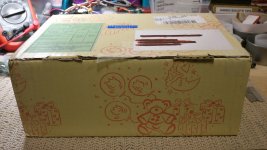 P1120109.jpg470.5 KB · Views: 444
P1120109.jpg470.5 KB · Views: 444 -
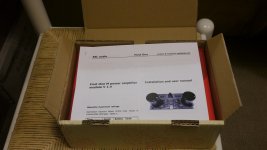 P1120112.jpg285.7 KB · Views: 438
P1120112.jpg285.7 KB · Views: 438 -
 P1120113.jpg383.2 KB · Views: 419
P1120113.jpg383.2 KB · Views: 419 -
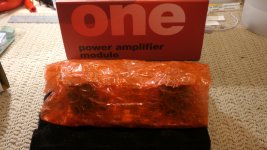 P1120118.jpg399 KB · Views: 421
P1120118.jpg399 KB · Views: 421 -
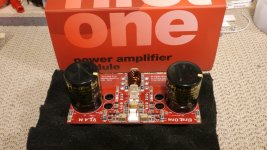 P1120121.jpg475.4 KB · Views: 425
P1120121.jpg475.4 KB · Views: 425 -
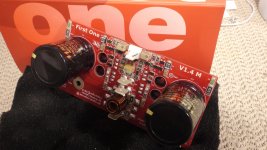 P1120124.jpg457.5 KB · Views: 209
P1120124.jpg457.5 KB · Views: 209 -
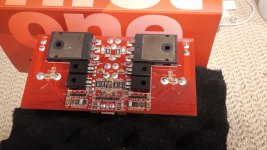 P1120125.jpg455 KB · Views: 233
P1120125.jpg455 KB · Views: 233 -
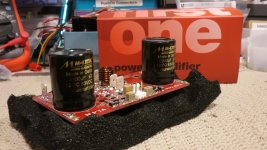 P1120128.jpg426.1 KB · Views: 244
P1120128.jpg426.1 KB · Views: 244 -
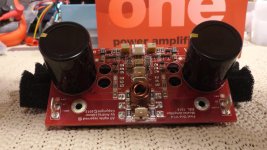 P1120129.jpg396.8 KB · Views: 227
P1120129.jpg396.8 KB · Views: 227 -
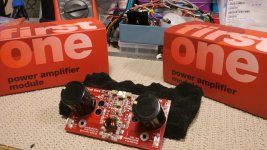 P1120130.jpg460.2 KB · Views: 234
P1120130.jpg460.2 KB · Views: 234
Only one channel has a problem? What if you swap the FO modules, does noise follow the same module? Are the calibration values correct? Did you connect them exactly as drawn in User manual schematic?Hi Lc ,couldn`t get rid of the Problem yet ,the Noise is coming out of the Tweeter.Sometimes it`s kind of pulsating.
I'm surprised since all modules passed factory calibration on the test bench, otherwise wouldn't be packed. Me personally installed 8 modules as an upgrade and no noise at 2 cm from tweeter.
Current First One M v1.4 has GND laid-out as best as possible, 5 mm from GND to -SP (GND) and 0 mm from Input GND to GND (direct connection from RCA's GND - no other parts connected to this track). It cannot be routed better, studied from v1.1 to v1.4, so we got no noise, hiss or hum at speaker's drivers membranes. 😉Lazy Cat, have not you considered adjusting position of input/output/power connectors for the next versions of amplifier?
Here is an insightful advice from Hypex:
Source: http://www.hypex.nl/docs/appnotes/EMI_appnote.pdf
P.S. First One is Class AB not switching amplfier.
Last edited:
Yes, already sent the technical drawings to production, awaiting mono-block chassis prototypes. It will be very simple three parts chassis only, dimensions W x H x D: 180 x 180 x 100 mm, SK519 heatsink inside. 😉Hi LC,
Is the mono chassis design you mentioned a while back still alive and on-going?
If yes, any schedule, picture to share and cost estimate for it?
Thanks,
Eric
- Home
- Vendor's Bazaar
- First One - mosFET amplifier module